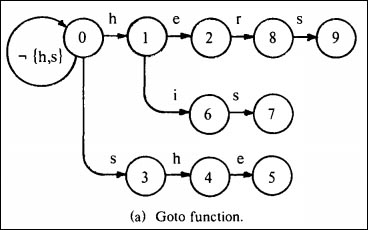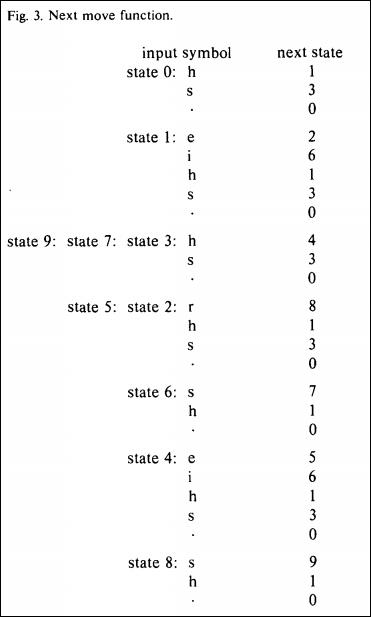在上篇 ac多模式匹配最后,有说到下面的冗余转移,这篇探讨下确定性有限自动机多模式匹配算法;

已知g(4,e) = 5; 假设M 当前状态为4, 且下一个字符不是'e',这时候M 会调用f(4)=1,其实这时候我们已经不需要去查找状态1以'e'为外向边的状态了,因为下一个字符确定不是'e';如果没有"his"模式,我们可以直接从状态1跳到状态0;而前面代码是会去做这个多余查找动作的。这个可以用确定有限自动机来避免;
确定性有限自动机用空间换时间,DFA由有限状态集S和Next函数δ 组成,对于每个状态s和输入字符a, 有δ(s,a)是有限状态集S的元素,可以说DFA使得每个状态转移变得唯一。
构造DFA的Next函数伪代码:

本例的Next表结果:

完整实现代码:
#include<iostream>
#include<string.h>
#include<malloc.h>
#include <queue>
using namespace std;
/* reallocation step for AC_NODE_t.matched_patterns */
#define REALLOC_CHUNK_MATCHED_PATTERN 1
/* reallocation step for AC_NODE_t.outgoing array */
#define REALLOC_CHUNK_OUTGOING 2
struct ac_edge;
typedef struct AC_PATTERN_s
{
const char * astring; /* String of alphabets */
unsigned int length; /* Length of pattern */
} AC_PATTERN_t;
typedef struct node{
int id; /* Node ID : just for debugging purpose */
unsigned short depth; /* depth: distance between this node and the root */
struct node *parent; /*parent node, for compute failure function*/
struct node *failure_node; /* The failure node of this node */
short int final; /* 0: no ; 1: yes, it is a final node */
//int patternNo; /*Accept pattern index: just for debugging purpose */
/* Matched patterns */
AC_PATTERN_t * matched_patterns; /* Array of matched patterns */
unsigned short matched_patterns_num; /* Number of matched patterns at this node */
unsigned short matched_patterns_max; /* Max capacity of allocated memory for matched_patterns */
/* Outgoing Edges */
struct ac_edge* outgoing_edge;/* Array of outgoing character edges */
unsigned short outgoing_num; /* Number of outgoing character edges */
unsigned short outgoing_max; /* Max capacity of allocated memory for outgoing character edges */
}AC_NODE_t;
/* The Ougoing Edge of the Node */
struct ac_edge
{
char alpha; /* Edge alpha */
AC_NODE_t * next; /* Target of the edge */
};
static void node_assign_id (AC_NODE_t * thiz);
static AC_NODE_t * node_find_next(AC_NODE_t * pAc_node, char ch);
/******************************************************************************
* Create node
******************************************************************************/
AC_NODE_t *node_create()
{
AC_NODE_t* pNode = (AC_NODE_t*)malloc(sizeof(AC_NODE_t));
memset(pNode, 0, sizeof(AC_NODE_t));
pNode->failure_node = NULL;
pNode->parent = NULL;
pNode->final = 0;
/*init matched pattern*/
pNode->matched_patterns_max = REALLOC_CHUNK_MATCHED_PATTERN;
pNode->matched_patterns = (AC_PATTERN_t *) malloc (pNode->matched_patterns_max*sizeof(AC_PATTERN_t));
/*init outgoing character edges*/
pNode->outgoing_max = REALLOC_CHUNK_OUTGOING;
pNode->outgoing_edge = (struct ac_edge *) malloc (pNode->outgoing_max*sizeof(struct ac_edge));
node_assign_id(pNode);
return pNode;
}
/******************************************************************************
* assign a unique ID to the node (used for debugging purpose).
******************************************************************************/
static void node_assign_id (AC_NODE_t * thiz)
{
static int unique_id = 0;
thiz->id = unique_id ++;
}
/******************************************************************************
* Establish an new edge between two nodes
******************************************************************************/
void node_add_outgoing (AC_NODE_t * thiz, AC_NODE_t * next, char alpha)
{
if(thiz->outgoing_num >= thiz->outgoing_max)
{
thiz->outgoing_max += REALLOC_CHUNK_OUTGOING;
thiz->outgoing_edge = (struct ac_edge *)realloc(thiz->outgoing_edge, thiz->outgoing_max*sizeof(struct ac_edge));
}
thiz->outgoing_edge[thiz->outgoing_num].alpha = alpha;
thiz->outgoing_edge[thiz->outgoing_num++].next = next;
}
/******************************************************************************
* Create a next node with the given alpha.
******************************************************************************/
AC_NODE_t * node_create_next (AC_NODE_t * pCur_node, char alpha)
{
AC_NODE_t * pNext_node = NULL;
pNext_node = node_find_next (pCur_node, alpha);
if (pNext_node)
{
/* The (labeled alpha) edge already exists */
return NULL;
}
/* Otherwise add new edge (node) */
pNext_node = node_create ();
node_add_outgoing(pCur_node, pNext_node, alpha);
return pNext_node;
}
/******************************************************************************
* Find out the next node for a given Alpha to move. this function is used in
* the pre-processing stage in which edge array is not sorted. so it uses linear search.
******************************************************************************/
static AC_NODE_t * node_find_next(AC_NODE_t * pAc_node, char ch)
{
int i = 0;
if(NULL == pAc_node)
{
return NULL;
}
for (i=0; i < pAc_node->outgoing_num; i++)
{
if(pAc_node->outgoing_edge[i].alpha == ch)
return (pAc_node->outgoing_edge[i].next);
}
return NULL;
}
/******************************************************************************
* Determine if a final node contains a pattern in its accepted pattern list or not.
* return : 1 = it had, 0 = it hadn't
******************************************************************************/
int node_had_match_ptn (AC_NODE_t * pAc_node, AC_PATTERN_t * pAc_ptn)
{
unsigned int i = 0, j = 0;
AC_PATTERN_t * pTmp_ptn = NULL;
for (i=0; i < pAc_node->matched_patterns_num; i++)
{
pTmp_ptn = &pAc_node->matched_patterns[i];
if (pTmp_ptn->length != pAc_ptn->length)
{
continue;
}
for (j=0; j<pTmp_ptn->length; j++)
{
if(pTmp_ptn->astring[j] != pAc_ptn->astring[j])
{
continue;
}
}
if (j == pTmp_ptn->length)
{
return 1;
}
}
return 0;
}
/******************************************************************************
* Adds the pattern to the list of accepted pattern.
******************************************************************************/
void node_register_match_ptn (AC_NODE_t * pAc_node, AC_PATTERN_t * pAc_ptn)
{
/* Check if the new pattern already exists in the node's matched patterns list */
if (node_had_match_ptn(pAc_node, pAc_ptn))
{
return;
}
/* Manage memory */
if (pAc_node->matched_patterns_num >= pAc_node->matched_patterns_max)
{
pAc_node->matched_patterns_max += REALLOC_CHUNK_MATCHED_PATTERN;
pAc_node->matched_patterns = (AC_PATTERN_t *) realloc
(pAc_node->matched_patterns, pAc_node->matched_patterns_max*sizeof(AC_PATTERN_t));
}
pAc_node->matched_patterns[pAc_node->matched_patterns_num].astring = pAc_ptn->astring;
pAc_node->matched_patterns[pAc_node->matched_patterns_num].length = pAc_ptn->length;
pAc_node->matched_patterns_num++;
}
/******************************************************************************
* add parent node's all leaf node(outgoing node) into queue
******************************************************************************/
int queue_add_leaf_node(AC_NODE_t *parent, queue<AC_NODE_t*> &ac_node_queue)
{
int i;
for (i = 0; i < parent->outgoing_num; i++)
{
ac_node_queue.push (parent->outgoing_edge[i].next);
}
return 0;
}
/******************************************************************************
* Initialize automata; allocate memories and add patterns into automata
******************************************************************************/
AC_NODE_t * ac_automata_create(char pattern[][255], int patterns_num)
{
int iPattern_index, iChar_index;
AC_NODE_t *root = node_create();
AC_NODE_t *pCur_node = NULL, *pNext_node = NULL;
char alpha;
AC_PATTERN_t pCur_ptn;
for(iPattern_index=0; iPattern_index<patterns_num; iPattern_index++)
{
pCur_node = root;
pCur_ptn.astring = pattern[iPattern_index];
pCur_ptn.length = strlen(pattern[iPattern_index]);
for(iChar_index=0; iChar_index<pCur_ptn.length; iChar_index++) ///对每个模式进行处理
{
alpha = *(pCur_ptn.astring+iChar_index);
pNext_node = node_find_next(pCur_node, alpha);
if(NULL != pNext_node)
{
pCur_node = pNext_node;
}
else
{
pNext_node = node_create_next(pCur_node, alpha);
if(NULL != pNext_node)
{
pNext_node->parent = pCur_node;
pNext_node->depth = pCur_node->depth + 1;
pCur_node = pNext_node;
}
}
}
pCur_node->final = 1;
node_register_match_ptn(pCur_node, &pCur_ptn);
}
return root;
}
/******************************************************************************
* find failure node for all node, actually failure function maps a state into a new state.
* the failure function is consulted whenever the goto function reports fail;
* specificialy compute the failue node, we use it's parent node's failure node
******************************************************************************/
int ac_automata_setfailure(AC_NODE_t * root)
{
int i =0;
queue<AC_NODE_t*> ac_node_queue;
char edge_ch = '\0';
AC_NODE_t *pCur_node = NULL, *parent = NULL, *pNext_Node = NULL;
for(i= 0; i< root->outgoing_num; i++) //f(s) = 0 for all states s of depth 1
{
root->outgoing_edge[i].next->failure_node = root;
}
queue_add_leaf_node(root, ac_node_queue);
while(!ac_node_queue.empty())
{
parent = ac_node_queue.front();
ac_node_queue.pop();
queue_add_leaf_node(parent, ac_node_queue);
for(i = 0; i < parent->outgoing_num; i++)
{
edge_ch = parent->outgoing_edge[i].alpha;
pCur_node = parent->outgoing_edge[i].next;
pNext_Node = node_find_next(parent->failure_node, edge_ch);
if(NULL == pNext_Node)
{
if(parent->failure_node == root)
{
pCur_node->failure_node = root;
}
else
{
parent = parent->failure_node->parent;
}
}
else
{
pCur_node->failure_node = pNext_Node;
}
}
}
return 0;
}
/******************************************************************************
* Collect accepted patterns of the node. the accepted patterns consist of the
* node's own accepted pattern plus accepted patterns of its failure node.
******************************************************************************/
void ac_automata_union_match_ptn(AC_NODE_t * root)
{
unsigned int i;
AC_NODE_t * pCur_node = root;
AC_NODE_t * pNext_node = NULL;
queue<AC_NODE_t*> ac_node_queue;
ac_node_queue.push( pCur_node );
while(!ac_node_queue.empty())
{
pCur_node = ac_node_queue.front();
ac_node_queue.pop();
pNext_node = pCur_node;
while ((pNext_node = pNext_node->failure_node))
{
for (i=0; i < pNext_node->matched_patterns_num; i++)
{
node_register_match_ptn(pCur_node, &(pNext_node->matched_patterns[i]));
}
if (pNext_node->final)
{
pCur_node->final = 1;
}
}
for (int i = 0; i < pCur_node->outgoing_num; i++)
{
ac_node_queue.push (pCur_node->outgoing_edge[i].next);
}
}
}
#if 1
AC_NODE_t * node_find_by_id(AC_NODE_t * root, int node_id)
{
int i = 0;
AC_NODE_t * pCur_node = root;
queue<AC_NODE_t*> ac_node_queue;
ac_node_queue.push( pCur_node );
while(!ac_node_queue.empty())
{
pCur_node = ac_node_queue.front();
if(node_id == pCur_node ->id)
{
return pCur_node;
}
ac_node_queue.pop();
for (int i = 0; i < pCur_node->outgoing_num; i++)
{
ac_node_queue.push (pCur_node->outgoing_edge[i].next);
}
}
return root;
}
static int delta[255][26] = {0};
void ac_automata_compute_deterministic_transition(AC_NODE_t * root, char * txt, int txt_len)
{
char alpha;
int i =0;
AC_NODE_t *pCur_node = NULL, *pNext_Node = NULL;
queue<AC_NODE_t*> ac_node_queue;
for(i = 0; i < txt_len; i++)
{
alpha = *(txt + i);
pNext_Node = node_find_next(root, alpha);
if(NULL != pNext_Node)
{
delta[0][alpha-'a'] = pNext_Node->id;
ac_node_queue.push( pNext_Node );
}
}
while(!ac_node_queue.empty())
{
pCur_node = ac_node_queue.front();
ac_node_queue.pop();
for(i = 0; i < txt_len; i++)
{
alpha = *(txt + i);
if(pNext_Node = node_find_next(pCur_node, alpha))
{
ac_node_queue.push ( pNext_Node );
delta[pCur_node->id][alpha-'a'] = pNext_Node->id;
}
else
{
delta[pCur_node->id][alpha-'a'] = delta[pCur_node->failure_node->id][alpha-'a'];
}
}
}
}
void ac_automata_display_deterministic_transition(char* text, int txt_len)
{
char alpha;
int i = 0;
for(i = 0; i < txt_len; i++)
{
alpha = *(text+i);
cout << delta[0][alpha - 'a'] << endl;;
}
return;
}
int ac_automata_deterministic_search(AC_NODE_t * root, char* text, int txt_len, char pattern[][255])
{
int i = 0;
char alpha;
AC_NODE_t *pCur_node = root;
int position = 0;
int node_id = 0;
while(position < txt_len)
{
alpha = *(text + position);
node_id = delta[pCur_node->id][alpha - 'a'];
pCur_node = node_find_by_id(root, node_id);
position++;
if(pCur_node->final == 1) ///some pattern matched
{
for(i = 0; i < pCur_node->matched_patterns_num; i++)
{
cout << position-pCur_node->matched_patterns[i].length << '\t' << '\t' << pCur_node->matched_patterns[i].astring <<endl;
}
}
}
return 0;
}
#endif
/******************************************************************************
* Search in the input text using the given automata.
******************************************************************************/
int ac_automata_search(AC_NODE_t * root, char* text, int txt_len, char pattern[][255])
{
int i = 0;
AC_NODE_t *pCur_node = root;
AC_NODE_t *pNext_node = NULL;
int position = 0;
while(position < txt_len)
{
pNext_node = node_find_next(pCur_node, text[position]);
if (NULL == pNext_node)
{
if(pCur_node == root)
{
position++;
}
else
{
pCur_node = pCur_node->failure_node;
}
}
else
{
pCur_node = pNext_node;
position++;
}
if(pCur_node->final == 1) ///some pattern matched
{
for(i = 0; i < pCur_node->matched_patterns_num; i++)
{
cout << position-pCur_node->matched_patterns[i].length << '\t' << '\t' << pCur_node->matched_patterns[i].astring <<endl;
}
}
}
return 0;
}
/******************************************************************************
* Prints the automata to output in human readable form.
******************************************************************************/
void ac_automata_display (AC_NODE_t * root)
{
unsigned int i;
AC_NODE_t * pCur_node = root;
struct ac_edge * pEdge = NULL;
if(root == NULL)
{
return;
}
printf("---------------------------------\n");
queue<AC_NODE_t*> ac_node_queue;
ac_node_queue.push( pCur_node );
while(!ac_node_queue.empty())
{
pCur_node = ac_node_queue.front();
ac_node_queue.pop();
printf("NODE(%3d)/----fail----> NODE(%3d)\n", pCur_node->id, (pCur_node->failure_node)?pCur_node->failure_node->id:0);
for (i = 0; i < pCur_node->outgoing_num; i++)
{
ac_node_queue.push (pCur_node->outgoing_edge[i].next);
pEdge = &pCur_node->outgoing_edge[i];
printf(" |----(");
if(isgraph(pEdge->alpha))
printf("%c)---", pEdge->alpha);
else
printf("0x%x)", pEdge->alpha);
printf("--> NODE(%3d)\n", pEdge->next->id);
}
printf("---------------------------------\n");
}
}
/******************************************************************************
* Release all allocated memories to the automata
******************************************************************************/
int ac_automata_release(AC_NODE_t * root)
{
if(root == NULL)
{
return 0;
}
queue<AC_NODE_t*> ac_node_queue;
AC_NODE_t *pCur_node = NULL;
ac_node_queue.push( root );
root = NULL;
while(!ac_node_queue.empty())
{
pCur_node = ac_node_queue.front();
ac_node_queue.pop();
for (int i = 0; i < pCur_node->outgoing_num; i++)
{
ac_node_queue.push (pCur_node->outgoing_edge[i].next);
}
free(pCur_node);
}
return 0;
}
int main()
{
unsigned int i = 0;
char haystack[] = "ushers";
char needle[4][255]={"he","she", "his","hers"};
/* 1. create ac finite state automata match machine, compute goto and output func*/
AC_NODE_t *root = ac_automata_create(needle, sizeof(needle)/sizeof(needle[0]));
/* 2. compute failure function*/
ac_automata_setfailure( root );
/*3 process those pattern is substring of other pattern, need add failure transition match pattern*/
ac_automata_union_match_ptn( root );
#if 1
ac_automata_compute_deterministic_transition(root, haystack, strlen(haystack));
ac_automata_display_deterministic_transition(haystack, strlen(haystack));
cout << endl << "haystack : " << haystack << endl;
cout << "needles : ";
for(i = 0; i<sizeof(needle)/sizeof(needle[0]); i++)
{
cout << needle[i] << " ";
}
cout << endl << endl;
cout << "match result : " << endl << "position\t" << "pattern" << endl;
ac_automata_deterministic_search(root, haystack, strlen(haystack), needle);
#else
/* 3. Display automata (if you are interested)*/
ac_automata_display( root );
cout << endl << "haystack : " << haystack << endl;
cout << "needles : ";
for(i = 0; i<sizeof(needle)/sizeof(needle[0]); i++)
{
cout << needle[i] << " ";
}
cout << endl << endl;
cout << "match result : " << endl << "position\t" << "node_id\t\t" << "pattern" << endl;
/* 3. seaching multi patterns use automata*/
ac_automata_search(root, haystack, strlen(haystack), needle);
#endif
/* 4. Release the automata */
ac_automata_release ( root );
return 0;
}后记:
1、上一篇的AC算法以及这篇的DFA都有个缺点,就是查找某个节点的下一个字符分支,需要去遍历查找,比较耗费时间。针对这个的改进可以使用Trie字典树,进一步利用空间来换取时间效能(网上有很多用Trie实现多模式匹配的文章)。
2、同时了解到正则表达式里有用到NFA以及DFA,本人对正则表达式不是很熟,看了下不甚了解,了解到:
1、NFA不需要读入字符也可以移动到下个状态;以及读入同一个字符可以转移到多个状态(没明白应用到哪里);
2、确定有限状态自动机在计算能力上等价于非确定有限状态自动机。
3、NFA 和 DFA 间可以互相转换;
等等,不确定这篇确定性有限自动机和DFA是否一样,熟悉的XDJM可以指教下.
有任何问题,还请不吝赐教~
references:
<1>、Efficient String Matching: An Aid to Bibliographic Search.pdf(june 1975)
<2>、精通正则表达式






















 577
577

 被折叠的 条评论
为什么被折叠?
被折叠的 条评论
为什么被折叠?








